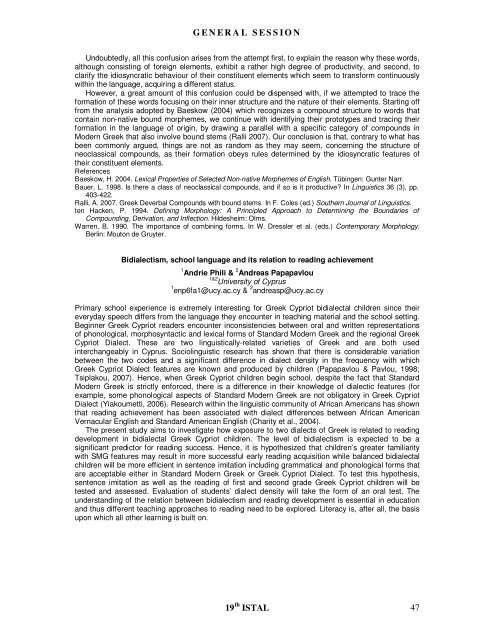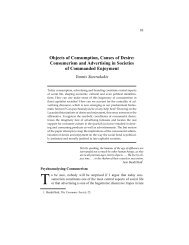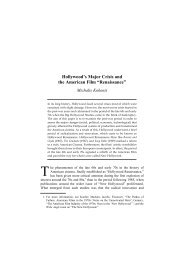19 International Symposium on Theoretical and Applied Linguistics ...
19 International Symposium on Theoretical and Applied Linguistics ...
19 International Symposium on Theoretical and Applied Linguistics ...
Create successful ePaper yourself
Turn your PDF publications into a flip-book with our unique Google optimized e-Paper software.
G E N E R A L S E S S I O N<br />
Undoubtedly, all this c<strong>on</strong>fusi<strong>on</strong> arises from the attempt first, to explain the reas<strong>on</strong> why these words,<br />
although c<strong>on</strong>sisting of foreign elements, exhibit a rather high degree of productivity, <strong>and</strong> sec<strong>on</strong>d, to<br />
clarify the idiosyncratic behaviour of their c<strong>on</strong>stituent elements which seem to transform c<strong>on</strong>tinuously<br />
within the language, acquiring a different status.<br />
However, a great amount of this c<strong>on</strong>fusi<strong>on</strong> could be dispensed with, if we attempted to trace the<br />
formati<strong>on</strong> of these words focusing <strong>on</strong> their inner structure <strong>and</strong> the nature of their elements. Starting off<br />
from the analysis adopted by Baeskow (2004) which recognizes a compound structure to words that<br />
c<strong>on</strong>tain n<strong>on</strong>-native bound morphemes, we c<strong>on</strong>tinue with identifying their prototypes <strong>and</strong> tracing their<br />
formati<strong>on</strong> in the language of origin, by drawing a parallel with a specific category of compounds in<br />
Modern Greek that also involve bound stems (Ralli 2007). Our c<strong>on</strong>clusi<strong>on</strong> is that, c<strong>on</strong>trary to what has<br />
been comm<strong>on</strong>ly argued, things are not as r<strong>and</strong>om as they may seem, c<strong>on</strong>cerning the structure of<br />
neoclassical compounds, as their formati<strong>on</strong> obeys rules determined by the idiosyncratic features of<br />
their c<strong>on</strong>stituent elements.<br />
References<br />
Baeskow, H. 2004. Lexical Properties of Selected N<strong>on</strong>-native Morphemes of English. Tübingen: Gunter Narr.<br />
Bauer, L. <str<strong>on</strong>g>19</str<strong>on</strong>g>98. Is there a class of neoclassical compounds, <strong>and</strong> if so is it productive? In <strong>Linguistics</strong> 36 (3), pp.<br />
403-422.<br />
Ralli, A. 2007. Greek Deverbal Compounds with bound stems. In F. Coles (ed.) Southern Journal of <strong>Linguistics</strong>.<br />
ten Hacken, P. <str<strong>on</strong>g>19</str<strong>on</strong>g>94. Defining Morphology: A Principled Approach to Determining the Boundaries of<br />
Compounding, Derivati<strong>on</strong>, <strong>and</strong> Inflecti<strong>on</strong>. Hildesheim: Olms.<br />
Warren, B. <str<strong>on</strong>g>19</str<strong>on</strong>g>90. The importance of combining forms. In W. Dressler et al. (eds.) C<strong>on</strong>temporary Morphology.<br />
Berlin: Mout<strong>on</strong> de Gruyter.<br />
Bidialectism, school language <strong>and</strong> its relati<strong>on</strong> to reading achievement<br />
1 Andrie Phili & 2 Andreas Papapavlou<br />
1&2 University of Cyprus<br />
1 enp6fa1@ucy.ac.cy & 2 <strong>and</strong>reasp@ucy.ac.cy<br />
Primary school experience is extremely interesting for Greek Cypriot bidialectal children since their<br />
everyday speech differs from the language they encounter in teaching material <strong>and</strong> the school setting.<br />
Beginner Greek Cypriot readers encounter inc<strong>on</strong>sistencies between oral <strong>and</strong> written representati<strong>on</strong>s<br />
of ph<strong>on</strong>ological, morphosyntactic <strong>and</strong> lexical forms of St<strong>and</strong>ard Modern Greek <strong>and</strong> the regi<strong>on</strong>al Greek<br />
Cypriot Dialect. These are two linguistically-related varieties of Greek <strong>and</strong> are both used<br />
interchangeably in Cyprus. Sociolinguistic research has shown that there is c<strong>on</strong>siderable variati<strong>on</strong><br />
between the two codes <strong>and</strong> a significant difference in dialect density in the frequency with which<br />
Greek Cypriot Dialect features are known <strong>and</strong> produced by children (Papapavlou & Pavlou, <str<strong>on</strong>g>19</str<strong>on</strong>g>98;<br />
Tsiplakou, 2007). Hence, when Greek Cypriot children begin school, despite the fact that St<strong>and</strong>ard<br />
Modern Greek is strictly enforced, there is a difference in their knowledge of dialectic features (for<br />
example, some ph<strong>on</strong>ological aspects of St<strong>and</strong>ard Modern Greek are not obligatory in Greek Cypriot<br />
Dialect (Yiakoumetti, 2006). Research within the linguistic community of African Americans has shown<br />
that reading achievement has been associated with dialect differences between African American<br />
Vernacular English <strong>and</strong> St<strong>and</strong>ard American English (Charity et al., 2004).<br />
The present study aims to investigate how exposure to two dialects of Greek is related to reading<br />
development in bidialectal Greek Cypriot children. The level of bidialectism is expected to be a<br />
significant predictor for reading success. Hence, it is hypothesized that children’s greater familiarity<br />
with SMG features may result in more successful early reading acquisiti<strong>on</strong> while balanced bidialectal<br />
children will be more efficient in sentence imitati<strong>on</strong> including grammatical <strong>and</strong> ph<strong>on</strong>ological forms that<br />
are acceptable either in St<strong>and</strong>ard Modern Greek or Greek Cypriot Dialect. To test this hypothesis,<br />
sentence imitati<strong>on</strong> as well as the reading of first <strong>and</strong> sec<strong>on</strong>d grade Greek Cypriot children will be<br />
tested <strong>and</strong> assessed. Evaluati<strong>on</strong> of students’ dialect density will take the form of an oral test. The<br />
underst<strong>and</strong>ing of the relati<strong>on</strong> between bidialectism <strong>and</strong> reading development is essential in educati<strong>on</strong><br />
<strong>and</strong> thus different teaching approaches to reading need to be explored. Literacy is, after all, the basis<br />
up<strong>on</strong> which all other learning is built <strong>on</strong>.<br />
<str<strong>on</strong>g>19</str<strong>on</strong>g> th ISTAL 47






